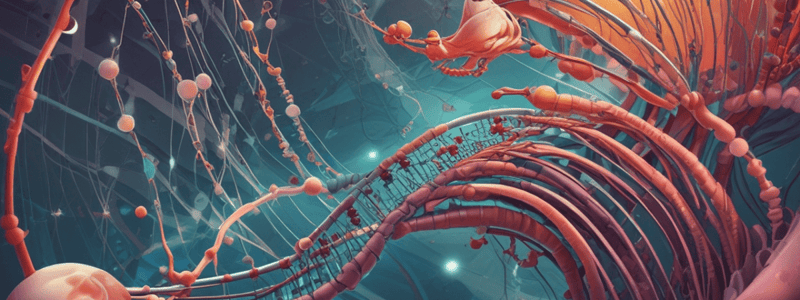Podcast
Questions and Answers
What is the primary purpose of adding adaptors during the RNA sequencing process?
What is the primary purpose of adding adaptors during the RNA sequencing process?
- To capture fragments containing exons (correct)
- To repair the ends of the RNA
- To add poly A tails to the RNA
- To enable PCR amplification
What is the function of the kanMX gene in targeted mutagenesis?
What is the function of the kanMX gene in targeted mutagenesis?
- It catalyzes the PCR reaction
- It provides a selective marker for the knockout construct (correct)
- It converts ganciclovir into a toxic nucleotide
- It searches for homology in the genome
What is the result of targeted mutagenesis by homologous recombination in yeast?
What is the result of targeted mutagenesis by homologous recombination in yeast?
- A knockout of a specific gene in a mammalian system
- A transgenic organism with an introduced gene
- A gene duplication event
- A null mutant with a knockout of specific genes (correct)
What is the purpose of ES cells in targeted mutagenesis in mouse?
What is the purpose of ES cells in targeted mutagenesis in mouse?
What is the estimated size of the final data generated from Whole-Genome-Sequencing?
What is the estimated size of the final data generated from Whole-Genome-Sequencing?
What is the main function of the CRISPR-Cas9 system in bacteria?
What is the main function of the CRISPR-Cas9 system in bacteria?
What is the role of PAM (protospacer adjacent motifs) in the CRISPR-Cas9 system?
What is the role of PAM (protospacer adjacent motifs) in the CRISPR-Cas9 system?
What is the result of using RNA interference (RNAi) in gene regulation?
What is the result of using RNA interference (RNAi) in gene regulation?
What is the difference between NHEJ and HDR in the CRISPR-Cas9 system?
What is the difference between NHEJ and HDR in the CRISPR-Cas9 system?
What is an advantage of using the CRISPR-Cas9 system for genome editing?
What is an advantage of using the CRISPR-Cas9 system for genome editing?
What is the primary function of restriction enzymes like EcoRI in bacteria?
What is the primary function of restriction enzymes like EcoRI in bacteria?
What is the purpose of genetic complementation analysis in yeast?
What is the purpose of genetic complementation analysis in yeast?
What is the result of combining a DNA fragment with a vector in DNA cloning?
What is the result of combining a DNA fragment with a vector in DNA cloning?
What is the purpose of using a plasmid as a vector in DNA cloning?
What is the purpose of using a plasmid as a vector in DNA cloning?
Flashcards are hidden until you start studying
Study Notes
Gene Knockout and Genome Editing
- Knockout mouse: a mouse in which a specific gene is knocked out in all tissues
- ES cells: Embryonic Stem cells used to create knockout mice
- Knockout construct can insert at the site of interest or somewhere else in the nuclear genome, which can be determined by ganciclovir sensitivity
- LoxP-Cre recombination can be used to knockout specific genes in specific cells or tissues
CRISPR-Cas System
- clusters of regularly-interspaced short palindromic repeats (CRISPR) were first observed in bacteria to recognize and digest foreign DNA
- CAS: CRISPR-associated proteins, such as nuclease Cas9, used to digest DNA
- CRISPR RNA (crRNA) and trans-activating CRISPR RNA (tracrRNA) are used to recognize specific DNA regions
- PAM (protospacer adjacent motifs) are important for guiding crRNA and tracrRNA to the gene of interest
- NHEJ (Non-homologous end-joining) and HDR (Homology Directed Repair) are two repair pathways used to repair double-stranded breaks
- Applications of CRISPR-Cas9 include genome editing, gene regulation, and future directions in human therapeutics and ecological engineering
Gene Inactivation
- RNA interference (RNAi) using siRNA (small interfering RNA) can be used to inactivate genes by degrading specific RNA
- Sequencing of DNA can be done using conventional sequencing, whole-genome sequencing, whole-exome sequencing, and transcriptome sequencing
Genetic Analysis
- Targeted mutagenesis by homologous recombination can be used to knockout specific genes in yeast and mouse
- Genetic complementation analysis can be used to determine whether recessive mutations are in the same or different genes
- Analysis of double mutants can reveal the order of steps in biosynthetic pathways and interacting or redundant proteins
DNA Cloning
- DNA cloning involves the replication of recombinant DNA within host cells
- Isolation, sequencing, and manipulation of purified DNA fragments can be done using DNA cloning
- A plasmid (vector) contains sequences to maintain it in the host, such as replication origin and selection marker gene
- Restriction enzymes, such as EcoRI, can be used to cleave palindromic sequences and create recombinant DNA
Studying That Suits You
Use AI to generate personalized quizzes and flashcards to suit your learning preferences.




